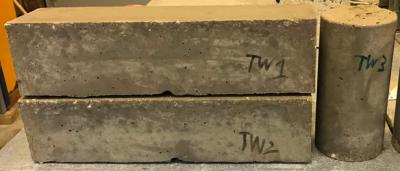The Graphene-Info newsletter (May 2018)
Published: Tue, 05/01/18
Exeter team creates innovative ‘green’ concrete using graphene
Researchers from the University of Exeter developed a new technique that incorporates graphene into traditional concrete production, to make more than twice as strong and four times more water resistant than existing concretes. The new graphene-reinforced concrete material also drastically reduced the carbon footprint of conventional concrete production methods, making it more sustainable and environmentally friendly.
All of the concrete samples tested have reportedly met British and European standards for construction. The research team states that the new technique could pave the way for other nano-materials to be incorporated into concrete, and so further modernize the construction industry worldwide.
In this new study, the research team has created a new technique that centers on suspending atomically thin graphene in water with high yield and no defects, low cost and compatible with modern, large scale manufacturing requirements.
New graphene-based device aims to eliminate drunk driving
Researchers at the India-based Uttarakhand Residential University, RI Instruments and Innovationin developed a new graphene-based technology to prevent vehicles from operating if the driver is drunk. In fact, the jointly developed device will make driving difficult if the driver is in an inebriated condition or feeling drowsy or is speaking on the mobile phone.
The prototype will be based on graphene generated from waste products and wild grasses as one of the components. Graphene has an important role in the device as graphene-coated electrodes can catalyze the process of oxidation of ethyl alcohol into acetic acid. The concentration of alcohol will automatically disconnect the device, the team said.
MIT team demonstrates a novel method to mass-produce graphene in long rolls
Researchers at MIT developed a method that might enable the production of long rolls of high-quality graphene. The continuous manufacturing process can reportedly produce five centimeters of high-quality graphene per minute. The longest run was nearly four hours, and it generated around 10 meters of continuous graphene.
MIT is referring to the development as “the first demonstration of an industrial, scalable method for manufacturing high-quality graphene that is tailored for use in membranes that filter a variety of molecules.” These membranes could be used in biological separation or desalination, for example. The researchers drew from the common industrial roll-to-roll approach blended with chemical vapor deposition, a common graphene-fabrication technique.
Indian team develops a graphene-based water cleaning process using seaweed
A team of Indian scientists developed a graphene-based nano-material drawn from seaweed for effective treatment of toxic wastewater without using any chemicals.
Membrane-based filtration processes are generally used to treat industrial wastewater but can’t usually fully filter out heavy metal contaminants. In order to address this problem, processes that use activated carbon, graphene or carbon nano tubes are being developed as carbon-based processes can help remove dyes and heavy metals through adsorption. Researchers at the Central Salt and Marine Chemicals Research Institute, Bhavnagar, have developed a 'green' process by using seaweed as starting material. They have synthesized a graphene-iron sulfide nanocomposite from an abundant seaweed - Ulva fasciata – through direct pyrolysis technique.
Graphene-Info interviews XFNano’s CEO to discuss the company’s business and technology
Mr. Xu Jiang, president and general manager of China’s XFNano, was kind enough to answer a few questions we had for him regarding XFNano’s graphene materials, technology and business. Mr. Jiang founded XFNano in 2009, and he holds a master’s degree from Nanjing University of Posts and Telecommunications.
Don’t miss Graphene-Info's Market Reports - now updated to April 2018
Graphene-Info has published new versions of all graphene market reports: Batteries, Graphene Oxide, Supercapacitors, Lighting, Displays and Graphene Investments.
The reports cover everything you need to know about these niche markets. The reports are now updated to April 2018.
Researchers at the Department of Chemistry of the University of Warsaw in Poland have developed a new graphene matrix, as a functional substrate for immobilizing enzymes, and the method of its preparation
Archer Exploration Limited announced a Collaboration Agreement with Flex-G (FlexeGRAPH) to jointly develop graphite and graphene based advanced materials for the thermal management of electric vehicle batteries, internal combustion engines, and high-performance computing systems.
Chalmers University in Sweden launched a project, which received Vinnova funding, to design a graphene-based speaker membrane that would be stiff and capable of efficiently dissipating the exceeding heat of the speaker.
Researchers at the Institute of Photonic Sciences (ICFO) in Spain, along with other members of the Graphene Flagship, reached what they consider to be the ultimate level of light confinement - being able to confine light down to a space of one atom.
Researchers from Nanjing University in China developed a new device of 3D hollow-cone structure based on a graphene oxide film that can greatly increase the solar-thermal conversion efficiency.
Versarien announced that it has signed an agreement with Luxus to develop a UK graphene-enhanced polymer supply chain, to enable the volume production of graphene enhanced plastics.
Versarien announced that it secured a purchase order for the Company's proprietary Nanene few layer graphene nano-platelets from a leading tyre producer, based in Europe.
A team of researchers from the University of Basel, the National Institute for Material Science in Tsukuba in Japan, Kanazawa University, Kwansei Gakuin University in Japan and Aalto University in Finland succeeded in using atomic force microscopy to obtain images of individual impurity atoms in graphene ribbons.
Researchers from the Russia-based Moscow Institute of Physics and Technology ('MIPT') developed biosensor chips of unprecedented sensitivity, which are based on copper combined with graphene oxide instead of the conventionally used gold.
Do you have a friend or a colleague that might be interested in Graphene technology? Forward this mail to update him on the world of Graphene.
If you received this email from a friend, subscribe to this newsletter here!







